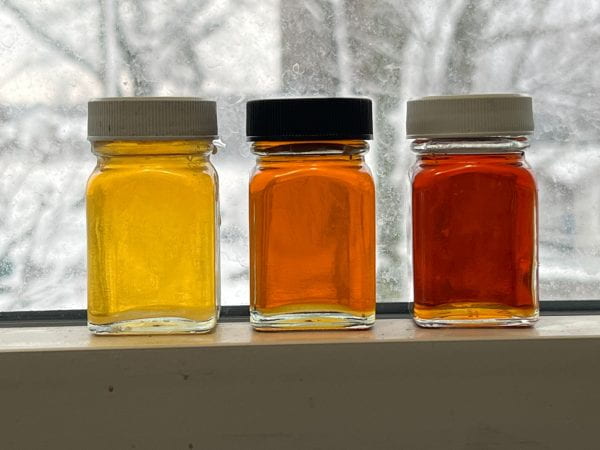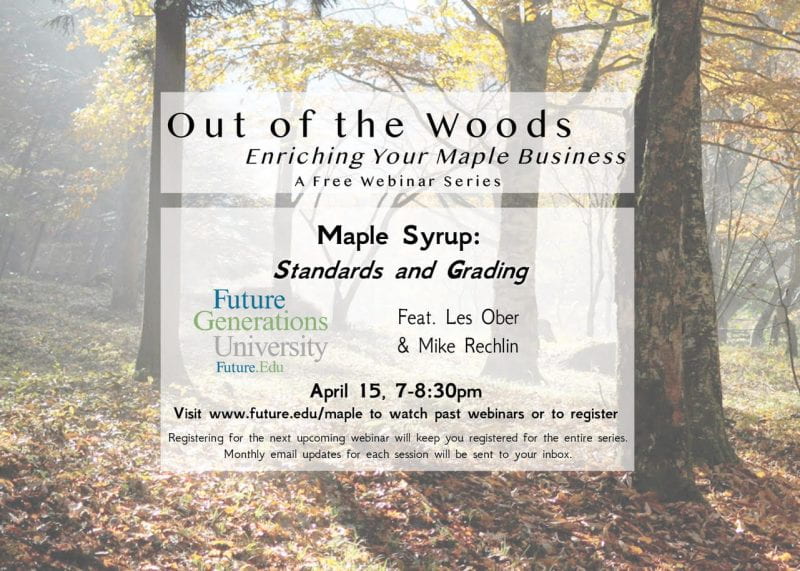This post is in response to Dr. Michael Farrell’s article on maple syrup quality from the most recent Maple News. First let me say that the article was not only excellent but very timely. The article addresses an issue that all maple syrup producers should consider as another season is upon us. What I hope to do is highlight some of the areas in the production process where syrup quality can be compromised often resulting in off flavors. The University of Vermont and the Vermont Ministry of Agriculture has provided an excellent tool for identifying the sources of off flavors in maple.
After producing maple syrup for over 40 years and teaching seminars on maple syrup production for close to 20, I have made or personally witnessed most of the common mistakes that lead to off flavors and poor syrup quality. In this article I will go over some, but certainly not all, of the factors that lead to poor syrup quality. The good news is that most of the factors can be controlled by producers with best practices, in turn meaning you control the quality of your syrup. The Map of Maple Off Flavors (linked above) identifies 5 primary areas where off flavors occur: Mother Nature, defoamer, processing, chemicals and others. I want to address each area in order of how they would occur from start of season to finish.
When you start out the season, you need to be aware of several problem areas that can lead to off flavors. Most problems arise from the previous season’s equipment maintenance and show their ugly faces as the new season kicks off. When producers ask how they should clean equipment, my response is with a lot of water and elbow grease – and my answer is the same from large-scale producers all the way down to backyard hobbyists. Anytime chemicals are used to clean equipment, residuals left behind can compromise flavor. If you use chemicals on your pans to clean them at the end of the season, you need to thoroughly scrub away any chemical residue. If you use a tubing cleaner, make sure it is flushed entirely from the system. If you store filters make sure there is no mold on those filters when you dig them out of storage. (And never use detergents to scrub away mold on filters, THROW THEM AWAY!) The list could go on. A final guideline for this area is to always store your chemicals in a secure place away from your syrup processing so as to avoid unintended contamination of your final product. Most of the above is common sense but they need to be mentioned.
Probably the biggest culprit for off flavors comes during the processing stage. This is where the majority of mistakes are made that result in off flavors. When we grade syrup, we look at 4 primary areas density, color, clarity, and flavor. Even though each is judged separately they are actually all interrelated. Syrup must be 66 Brix to meet USDA standards and if it is below 66 Brix it can ferment and cause an off flavor. Syrup above 67 Brix normally does not have an off flavor but the higher density can cause crystallization in the bottom of each container resulting in lost revenue to the producer. As syrup moves across the front pan, density and color changes rapidly. Density changing with the rapid removal of water that increases sugar concentration, and color as heat changes the sugar molecules. Anything that interferes with flow of sap through the evaporator can cause the syrup to get darker and possibly cause an off flavor. Many feel that density is the most critical part of the process and at times reaching the proper density can be very difficult. Improper density management can lead to two off flavors that are very common in syrup – fermented and scorched. And these off flavors are often accompanied by undesirable colors as well.
We use three tools to measure density, the hydrometer, the thermometer and the refractometer. All sugarmakers use a hydrometer. Hydrometers should be inspected or checked for possible problems and replaced if suspect. Often the paper with the scale printed on it can slip resulting in the wrong Brix reading. Hydrometers can become coated with film resulting in inaccurate readings. A good hydrometer will give you an accurate reading only if it is used at the right temperature. Temperatures below that require consulting a chart to convert to the right Brix reading based on the specific temperature. Maple syrup boils at 7 degrees Fahrenheit above the boiling point of water or 219 degrees, and many producers use a thermometer to determine the draw off point. The only problem is that the 219 reading is only accurate if the barometer is at 29.9 Hg barometric pressure. Therefore, a thermometer needs to be recalibrated every time the barometric pressure rise or falls. Having an accurate syrup temperature is especially vital when it comes to setting an automatic draw off.
The final tool is what many consider the grand judge and jury of maple syrup density – the refractometer. For a refractometer to work properly, syrup must be finished and stable in temperature. This was pointed out the other day in a conversation with Robert Crooks of Marcland Instruments. For a refractometer to work properly, it has to be able to refract light coming through the sample and that can only be done accurately if the sample in the instrument is a clear finished sample. Taking a sample of cloudy unfiltered syrup will lead to an inaccurate reading. The temperature of the syrup also affects light refraction. Even though refractometers are built to automatically compensate for temperature, temperature must be stable. If you leave freshly drawn off syrup set in a container, it will continue to evaporate water until it cools down. Think of what happens to a pot roast when you pull it from the oven, it continues to cook beyond the temperature when you pulled it from the oven. This is why it is best practice to cover containers of hot unfiltered syrup in order to stop moisture loss. If you use a refractometer to set the draw off, run a sample of syrup through your filter and allow the sample to sit for 15 minutes before taking your refractometer reading. This will give you the most accurate reading from your refractometer.
If you use a conventional auto draw-off, be aware that it takes time to complete the draw off process. This means that syrup will be drawn off over a range of temperatures. Therefore set the draw off to actuate slightly below the desired temperature and it will finish slightly above. Using a hydrometer is the best way to set your draw off. However, make sure you are reading the hydrometer at the recommended syrup temperature. You can use a refractometer but remember it must be used on a finished, stable-temperature product, and this process may take more time than you have to make a correction on the draw-off.
As sap moves across the evaporator, a temperature gradient sets up. Ninety percent of the water is removed by the time the sap reaches the middle of the front pan, so syrup needs to move from the middle of the syrup pan to the outlet relatively fast to avoid darker and denser syrup than desired. A common mistake is to allow the pans to cool during the firing process. Anytime you cool off the pans, the temperature of the sap drops and this causes the boiling temperature to drop resulting in the sap on one side of the gradient to mix with sap on the other. Keeping constant and stable heat levels on the front pan is must and particularly crucial for wood-fired evaporators.
Another problem is foam control. Excessive foam in the back pan can cause problems with your float and may interfere with your ability to control the level of the sap in the evaporator. If this happens you will need to use a defoamer to control the problem. When using defoamer, the only place the defoamer should be added is at the point where sap enters the rear pan, and occasionally a couple of drops if needed at the draw-off if foam builds up as you are drawing off. This should be done at regular intervals placing the prescribed number of drops (2 drops per foot of width) where the sap enters the evaporator. Never spray defoamer across the front pan to control foam. Using defoamer in this manner will impede the boil and break down the temperature gradient. This can lead to the dreaded big batch. If the front pan is foaming excessively, then the foam is not being properly controlled in the back pan, correct the problem back there. Use only small amounts of defoamer, excessive use can result in an off flavor. Organic producers must use safflower or canola oils which are very poor defoamers. And be careful with organic products as well because an excessive amount can produce off flavors.
Another potential problem (there are a lot of them, right?!) is niter build-up which can lead to scorching in your evaporator. Any niter build-ups will insulate the bottom of the pan from the syrup creating a potential hot spot which can eventually result in a scorched spot on the pan. You must keep liquid in contact with the pan at all times. Always keep your pans as niter free as possible by rotating sides or using a clean set of pans between batches. Using a good syrup filtering system to remove niter is vital if you want to produce syrup that meets the highest clarity standards. You should be able to read newspaper print through a sample bottle of syrup that has been properly filtered. Cloudy syrup with a lot of niter can produce an off flavor. Remember every time you heat your syrup to a boil, more niter will precipitate out and needs to be re-filtered. That is why you do not want to bring your syrup to a full boil when canning. 185 degrees Fahrenheit is the required temperature for canning.
As maple producers, we fight the growth of bacteria through our entire system. When bacterial colonies multiply in sap, they convert Sucrose sugar molecules to Glucose and other invert sugar molecules. This increase in invert sugar, when exposed to heat, will lead to a darker finished product. This is most prevalent at the end of the season when the bacterial content of sap is at its highest. Bacteria can affect the entire process of making syrup from the taphole to canning. Because sap has sugar content, it is a perfect media for bacterial growth. It goes without saying you can never be too clean when it comes to making syrup. Sap needs to be collected in clean equipment, it needs to be kept cool, and it must be processed quickly. If you start with a properly sanitized system at season’s beginning, you will have far fewer issues at season’s end – though issues may still crop up. Maple producers need to know when to end the season. Producing syrup late in the season when the trees are near budding and the sap is out of peak condition has little value to you and even less to the industry’s customers.
As you can see, there are many factors that a sugarmaker must consider in order to maintain the highest standards of product quality. From equipment sanitation to efficiency throughout processing, paying attention to details is critical and is what separates the best producers from the rest of the pack. Making the highest quality product possible should be your goal. Your reputation as a maple producer depends on it.
Author: Les Ober, Geauga County OSU Extension 










